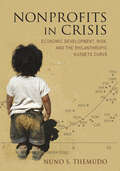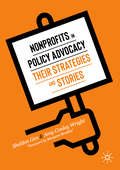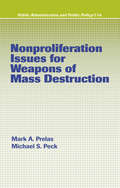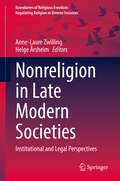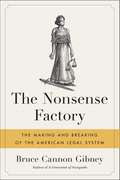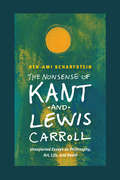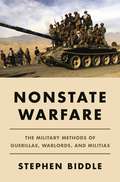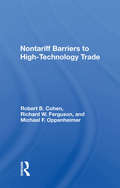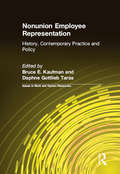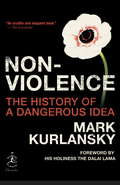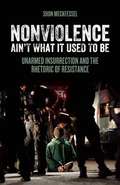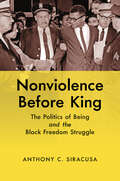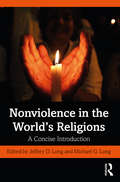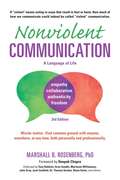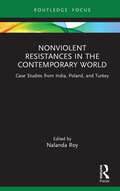- Table View
- List View
Nonprofits in Crisis: Economic Development, Risk, and the Philanthropic Kuznets Curve
by Nuno S. ThemudoWhy do some countries have a vibrant non-profit sector while others do not?Nonprofits in Crisisexplores the theory of risk as a major mechanism through which economic development influences the non-profit sector. Nuno S. Themudo elaborates this idea by focusing on Mexican non-profit organizations, which operate and strive to survive in a risky environment. The study of these nonprofits generates broader lessons about philanthropy and the non-profit sector that complement wider cross-national statistical analysis.
Nonprofits in Policy Advocacy: Their Strategies and Stories
by Sheldon Gen Amy Conley WrightPolicy advocacy is an increasingly important function of many nonprofit organizations, as they seek broad social changes in their concerning issues. Their advocacy practices, however, have often been guided by their own past experiences, anecdotes from peer networks, and consultant advice. Most of their practices have largely escaped empirical and theoretical grounding that could better root their work in established theories of policy change. The first book of its kind, Nonprofits in Policy Advocacy bridges this gap by connecting real practices of on-the-ground policy advocates with the burgeoning academic literature in policy studies. In the process, it empirically identifies six distinct policy advocacy strategies, and their accompanying tactics, used by nonprofits. Case studies tell the stories of how advocates apply these strategies in a wide variety of issues including civil rights, criminal justice, education, energy, environment, public health, public infrastructure, and youth. This book will appeal to both practitioners and academicians, as each gains insights into the other’s views of policy change and the actions that produce it.
Nonproliferation Issues For Weapons of Mass Destruction (Public Administration and Public Policy)
by Mark A. Prelas Michael S. PeckNonproliferation Issues for Weapons of Mass Destruction provides an understanding of WMD proliferation risks by bridging complex technical and political issues. The text begins by defining the world conditions that foster proliferation, followed by an analysis of characteristics of various classes of WMDs, including nuclear, biological, and chemica
Nonproliferation Policy and Nuclear Posture: Causes and Consequences for the Spread of Nuclear Weapons (Routledge Global Security Studies)
by Nei Narang Eri Gartzke Matthe KroenigThis volume examines the causes and consequences of nuclear postures and nonproliferation policies. The real-world importance of nuclear weapons has led to the production of a voluminous scholarly literature on the causes and consequences of nuclear weapons proliferation. Missing from this literature, however, is a more nuanced analysis that moves beyond a binary treatment of nuclear weapons possession, to an exploration of how different nuclear postures and nonproliferation policies may influence the proliferation of nuclear weapons and subsequent security outcomes. This volume addresses this deficit by focusing on the causes and consequences of nuclear postures and nonproliferation policies. It is the aim of this book to advance the development of a new empirical research agenda that brings systematic research methods to bear on new dimensions of the nuclear weapons phenomenon. Prior to the contributions in this volume, there has been little evidence to suggest that nuclear postures and policies have a meaningful impact on the spread of nuclear weapons or security outcomes. This book brings together a new generation of scholars, advancing innovative theoretical positions, and performing quantitative tests using original data on nuclear postures, nonproliferation policies, and WMD proliferation. Together, the chapters in this volume make novel theoretical, empirical, and methodological contributions to the field of nuclear weapons proliferation. This book will be of much interest to students of nuclear proliferation, international relations and security studies.
Nonreligion in Late Modern Societies: Institutional and Legal Perspectives (Boundaries of Religious Freedom: Regulating Religion in Diverse Societies)
by Anne-Laure Zwilling Helge ÅrsheimThis volume presents results from new and ongoing research efforts into the role of nonreligion in education, politics, law and society from a variety of different countries. Featuring data from a wide range of quantitative and qualitative studies, the book exposes the relational dynamics of religion and nonreligion. Firstly, it highlights the extent to which nonreligion is defined and understood by legal and institutional actors on the basis of religions, and often replicates the organisation of society and majority religions. At the same time, it displays how essential it is to approach nonreligion on its own, by freeing oneself from the frameworks from which religion is thought.The book addresses pressing questions such as: How can nonreligion be defined, and how can the “nones” be grasped and taken into account in studies on religion? How does the sociocultural and religious backdrop of different countries affect the regulation and representation of nonreligion in law and policymaking? Where and how do nonreligious individuals and collectives fit into institutions in contemporary societies? How does nonreligion affect notions of citizenship and national belonging? Despite growing scholarly interest in the increasing number of people without religion, the role of nonreligion in legal and institutional settings is still largely unexplored.This volume helps fill the gap, and will be of interest to students, researchers, policymakers and others seeking deeper understanding of the changing role of nonreligion in modern societies.
The Nonsense Factory: The Making and Breaking of the American Legal System
by Bruce Cannon GibneyA withering and witty examination of how the American legal system, burdened by complexity and untrammeled growth, fails Americans and threatens the rule of law itself, by the acclaimed author of A Generation of Sociopaths.Our trial courts conduct hardly any trials, our correctional systems do not correct, and the rise of mandated arbitration has ushered in a shadowy system of privatized "justice." Meanwhile, our legislators can't even follow their own rules for making rules, while the rule of law mutates into a perpetual state of emergency. The legal system is becoming an incomprehensible farce. How did this happen?In The Nonsense Factory, Bruce Cannon Gibney shows that over the past seventy years, the legal system has dangerously confused quantity with quality and might with legitimacy. As the law bloats into chaos, it staggers on only by excusing itself from the very commands it insists that we obey, leaving Americans at the mercy of arbitrary power. By examining the system as a whole, Gibney shows that the tragedies often portrayed as isolated mistakes or the work of bad actors -- police misconduct, prosecutorial overreach, and the outrages of imperial presidencies -- are really the inevitable consequences of law's descent into lawlessness.The first book to deliver a lucid, comprehensive overview of the entire legal system, from the grandeur of Constitutional theory to the squalid workings of Congress, The Nonsense Factory provides a deeply researched and witty examination of America's state of legal absurdity, concluding with sensible options for reform.
The Nonsense of Kant and Lewis Carroll: Unexpected Essays on Philosophy, Art, Life, and Death
by Ben-Ami ScharfsteinWhat if Immanuel Kant floated down from his transcendental heights, straight through Alice’s rabbit hole, and into the fabulous world of Lewis Carroll? For Ben-Ami Scharfstein this is a wonderfully instructive scenario and the perfect way to begin this wide-ranging collection of decades of startlingly synthesized thought. Combining a deep knowledge of psychology, cultural anthropology, art history, and the history of religions—not to mention philosophy—he demonstrates again and again the unpredictability of writing and thought and how they can teach us about our experiences. Scharfstein begins with essays on the nature of philosophy itself, moving from an autobiographical account of the trials of being a comparativist to philosophy’s function in the outside world to the fear of death in Kant and Hume. From there he explores an impressive array of art: from China and Japan to India and the West; from an essay on sadistic and masochistic body art to one on the epistemology of the deaf and the blind. He then returns to philosophy, writing on Machiavelli and political ruthlessness, then on the ineffable, and closes with a review of Walter Kaufmann’s multivolume look at the essence of humanity, Discovering the Mind. Altogether, these essays are a testament to adventurous thought, the kind that leaps to the furthest reaches of the possible.
Nonsense upon Stilts: Bentham, Burke and Marx on the Rights of Man (Routledge Revivals)
by Jeremy WaldronIn Nonsense upon Stilts¸ first published in 1987, Waldron includes and discusses extracts from three classic critiques of the idea of natural rights embodied in the 1789 Declaration of the Rights of Man and the Citizen. Each text is prefaced by an historical introduction and an analysis of its main themes. The collection as a whole in introduced with an essay tracing the philosophical background to the three critiques as well as the eighteenth-century idea of natural rights which they attacked. But the point of reproducing these works is not merely historical. Modern attacks on ‘rights-based’ political philosophy mirror the concerns of Bentham, Burke and Marx. Jeremy Waldron has therefore added an extensive concluding essay which relates these classic texts to the modern discussion of rights and re-examines the idea of rights in the light of contemporary critiques. This text provides an invaluable teaching tool for courses in politics and philosophy.
Nonstate Actors In International Politics: From Transregional To Substate Organizations
by Phillip TaylorOne of the most notable trends in the study of international relations is the resurgence of interest in international organizations, particularly those outside the United Nations. Regional international governmental organizations, multinational corporations, international labor unions, and transnational ethnic groups have become increasingly salient actors in world politics. OPEC, NATO, EEC, and PLO, for example, are all widely understood acronyms, and even a casual review of the crises in Iran and Afghanistan reveals the pervasive involvement of NATO, the European Community, the Islamic Conference, the International Olympic Committee, and more than one hundred other international governmental and nongovernmental organizations. Although international organizations are not likely to replace nation-states as the primary actors in world politics, their growing involvement in global political and economic issues challenges the assumptions of the traditionalists' state-centric model, as well as those whose interests begin and end with the United Nations. This book goes beyond the traditional UN-focused studies of nonstate actors to provide students with a comprehensive analytical survey of the many other organizations that help shape today's events. A common framework is used to examine what each nonstate actor does, how it organizes to achieve its ends, and how it makes multilateral/international decisions. The degree of integration in each nonstate actor is evaluated.
Nonstate Actors in Intrastate Conflicts (National and Ethnic Conflict in the 21st Century)
by Dan Miodownik Oren BarakIntrastate conflicts, such as civil wars and ethnic confrontations, are the predominant form of organized violence in the world today. But internal strife can destabilize entire regions, drawing in people living beyond state borders—particularly those who share ideology, ethnicity, or kinship with one of the groups involved. These nonstate actors may not be enlisted in formal armies or political parties, but they can play a significant role in a conflict. For example, when foreign volunteers forge alliances with domestic groups, they tend to attract other foreign interventions and may incite the state to centralize its power. Diasporan populations, depending on their connection to their homeland, might engage politically through financial support or overt aggression, either exacerbating or mitigating the conflict.Nonstate Actors in Intrastate Conflicts takes an interdisciplinary approach to understanding the ways external individuals and groups become entangled with volatile states and how they influence the outcome of hostilities within a country's borders. Editors Dan Miodownik and Oren Barak bring together top scholars to examine case studies in Afghanistan, Lebanon, Israel/Palestine, and Turkey in order to explore the manifold roles of external nonstate actors. By shedding light on these overlooked participants—whose causes and consequences can turn the tide of war—Nonstate Actors in Intrastate Conflicts provides a critical new perspective on the development and neutralization of civil war and ethnic violence.Contributors: Oren Barak, Chanan Cohen, Robert A. Fitchette, Orit Gazit, Gallia Lindenstrauss, Nava Löwenheim, David Malet, Dan Miodownik, Maayan Mor, Avraham Sela, Gabriel (Gabi) Sheffer, Omer Yair.
Nonstate Warfare: The Military Methods of Guerillas, Warlords, and Militias
by Stephen BiddleHow nonstate military strategies overturn traditional perspectives on warfareSince September 11th, 2001, armed nonstate actors have received increased attention and discussion from scholars, policymakers, and the military. Underlying debates about nonstate warfare and how it should be countered is one crucial assumption: that state and nonstate actors fight very differently. In Nonstate Warfare, Stephen Biddle upturns this distinction, arguing that there is actually nothing intrinsic separating state or nonstate military behavior. Through an in-depth look at nonstate military conduct, Biddle shows that many nonstate armies now fight more "conventionally" than many state armies, and that the internal politics of nonstate actors—their institutional maturity and wartime stakes rather than their material weapons or equipment—determines tactics and strategies.Biddle frames nonstate and state methods along a continuum, spanning Fabian-style irregular warfare to Napoleonic-style warfare involving massed armies, and he presents a systematic theory to explain any given nonstate actor’s position on this spectrum. Showing that most warfare for at least a century has kept to the blended middle of the spectrum, Biddle argues that material and tribal culture explanations for nonstate warfare methods do not adequately explain observed patterns of warmaking. Investigating a range of historical examples from Lebanon and Iraq to Somalia, Croatia, and the Vietcong, Biddle demonstrates that viewing state and nonstate warfighting as mutually exclusive can lead to errors in policy and scholarship.A comprehensive account of combat methods and military rationale, Nonstate Warfare offers a new understanding for wartime military behavior.
Nontariff Barriers: The Effects On Corporate Strategy In High-technology Sectors
by Michael F. OppenheimerThis book explores the impact of Japanese and European nontariff barriers (NTBs) on the international marketing, investment, and technology strategies of small- to medium-sized high-technology U.S. firms. The study documents a pronounced dichotomy between strategies of small and large companies that, to a significant extent, reflects the gap in the resources, bargaining power, and familiarity with foreign markets of these two groups. Conclusions concerning the efficacy of corporate strategies adopted are supported by an analysis of over 20 case studies. These strategies range from licensing agreements with local firms to use of a trading company or local distributor, formation of a joint venture with a local firm, and establishment of a wholly owned subsidiary in the foreign market.
Nontariff Barriers To High-technology Trade
by Robert B. CohenThis book describes European and Japanese nontariff barriers (NTBs) in areas of high-technology trade and discusses their impact on the international behavior of U.S. firms. This study was prompted by the rising incidence of nontariff measures in high-technology sectors, as governments increasingly attempt to promote the growth of new industries th
Nontaxation and Representation
by Kevin M. MorrisonDoes oil make countries autocratic? Can foreign aid make countries democratic? Does taxation lead to representation? In this book, Kevin M. Morrison develops a novel argument about how government revenues of all kinds affect political regimes and their leaders. Contrary to conventional wisdom, Morrison illustrates that taxation leads to instability, not representation. With this insight, he extends his award-winning work on nontax revenues to encompass foreign aid, oil revenue, and intergovernmental grants and shows that they lead to decreased taxation, increased government spending, and increased political stability. Looking at the stability of democracies and dictatorships as well as leadership transitions within those regimes, Morrison incorporates cross-national statistical methods, formal modeling, a quasi-experiment, and case studies of Brazil, Kenya, and Mexico to build his case. This book upends many common hypotheses and policy recommendations, providing the most comprehensive treatment of revenue and political stability to date.
Nontraditional Security Concerns in India: Issues and Challenges
by Shantesh Kumar Singh Shri Prakash SinghThis book deals with the constantly evolving, vast, and diverse field of nontraditional security. Nontraditional security goes beyond military security and focuses primarily on socioeconomic security. Its major concern is human beings rather than border or territory of the state. The book focuses on nontraditional securities such as human security, energy security, food security, environmental security, cybersecurity, health security, terrorism, drug trafficking, human trafficking, biological, and chemical weapons. All the nontraditional security issues are highly relevant for academics and policy makers as well.
Nonunion Employee Representation: History, Contemporary Practice and Policy
by Bruce E. Kaufman Daphne Gottlieb TarasExamines the history, contemporary practice, and policy issues of non-union employee representation in the USA and Canada. The text encompasses many organizational devices that are organized for the purposes of representing employees on a range of production, quality, and employment issues.
Nonviolence: The History of a Dangerous Idea
by Mark KurlanskyIn this timely, highly original, and controversial narrative, New York Times bestselling author Mark Kurlansky discusses nonviolence as a distinct entity, a course of action, rather than a mere state of mind. Nonviolence can and should be a technique for overcoming social injustice and ending wars, he asserts, which is why it is the preferred method of those who speak truth to power. Nonviolence is a sweeping yet concise history that moves from ancient Hindu times to present-day conflicts raging in the Middle East and elsewhere. Kurlansky also brings into focus just why nonviolence is a "dangerous" idea, and asks such provocative questions as: Is there such a thing as a "just war"? Could nonviolence have worked against even the most evil regimes in history?Kurlansky draws from history twenty-five provocative lessons on the subject that we can use to effect change today. He shows how, time and again, violence is used to suppress nonviolence and its practitioners-Gandhi and Martin Luther King, for example; that the stated deterrence value of standing national armies and huge weapons arsenals is, at best, negligible; and, encouragingly, that much of the hard work necessary to begin a movement to end war is already complete. It simply needs to be embraced and accelerated.Engaging, scholarly, and brilliantly reasoned, Nonviolence is a work that compels readers to look at history in an entirely new way. This is not just a manifesto for our times but a trailblazing book whose time has come.From the Hardcover edition.
Nonviolence Ain't What it Used to Be: Unarmed Insurrection and the Rhetoric of Resistance
by Shon Meckfessel"Shon Meckfessel . . . brings a fresh perspective to the stubborn debates around violence and nonviolence and suggests a way to move beyond the left's tactical impasse. Nonviolence Ain't What It Used to Bewon't settle the old argument, but it may start a new one. "—Kristian Williams,Our Enemies in Blue: Police and Power in America Shon Meckfessel takes an innovative look at challenges faced by twenty-first century social movements in the US. One of their most important stumbling blocks is the question of nonviolence. Civil disobedience, symbolic protest, and principles of nonviolence have characterized many struggles in the United States since the Civil Rights era. But as Meckfessel argues, conditions have changed. We've seen the consolidation of the media, the militarization of policing, the co-optation and institutionalization of dissent, among many other shifts. The rules have changed, but the rhetoric, logic, and strategic tools we employ haven't necessarily kept pace, and narratives borrowed from movements of the past are falling short. Nonviolence Ain't What It Used to Bemaps the emerging, more militant approaches that seem to be developing to fill the gap, from Occupy to Ferguson. It offers new angles on a seemingly intractable debate, introducing terms and criteria that carve out a larger middle-ground between the two camps, in order to chart a path forward. Shon Meckfesselis the author ofSuffled How It Gush: A North American Anarchist in the Balkansas well as numerous essays and articles. He is a member of the English faculty at Highline College in Seattle, Washington.
Nonviolence before King: The Politics of Being and the Black Freedom Struggle (Justice, Power, and Politics)
by Anthony C. SiracusaIn the early 1960s, thousands of Black activists used nonviolent direct action to challenge segregation at lunch counters, movie theaters, skating rinks, public pools, and churches across the United States, battling for, and winning, social change. Organizers against segregation had used litigation and protests for decades but not until the advent of nonviolence did they succeed in transforming ingrained patterns of white supremacy on a massive scale. In this book, Anthony C. Siracusa unearths the deeper lineage of anti-war pacifist activists and thinkers from the early twentieth century who developed nonviolence into a revolutionary force for Black liberation.Telling the story of how this powerful political philosophy came to occupy a central place in the Black freedom movement by 1960, Siracusa challenges the idea that nonviolent freedom practices faded with the rise of the Black Power movement. He asserts nonviolence's staying power, insisting that the indwelling commitment to struggle for freedom collectively in a spirit of nonviolence became, for many, a lifelong commitment. In the end, what was revolutionary about the nonviolent method was its ability to assert the basic humanity of Black Americans, to undermine racism's dehumanization, and to insist on the right to be.
The Nonviolence Handbook
by Michael N NaglerLove Is Stronger Than Hate "Nonviolence is not the recourse of the weak but actually calls for an uncommon kind of strength; it is not a refraining from something but the engaging of a positive force," renowned peace activist Michael Nagler writes. Here he offers a step-by-step guide to creatively using nonviolence to confront any problem and to build change movements capable of restructuring the very bedrock of society. Nagler identifies some specific tactical mistakes made by unsuccessful nonviolent actions such as the Tiananmen Square demonstrations and the Occupy protests and includes stories of successful nonviolent resistance from around the world, including an example from Nazi Germany. And he shows that nonviolence is more than a tactic--it is a way of living that will enrich every area of our lives.
Nonviolence in the World’s Religions: A Concise Introduction
by Jeffery D. Long Michael G. LongThe twenty-first century began with the terrorist attacks of September 11, 2001. Much has been written and debated on the relationship between faith and violence, with acts of terror at the forefront. However, the twentieth century also gave rise to many successful nonviolent protest movements. Nonviolence in the World’s Religions introduces the reader to the complex relationship between religion and nonviolence. Each of the essays delves into the contemporary and historical expressions of the world’s major religious traditions in relation to nonviolence. Contributors explore the literary and theological foundations of a tradition’s justification of nonviolence; the ways that nonviolence has come to expression in its beliefs, symbols, rituals, and other practices; and the evidence of nonviolence in its historic and present responses to conflict and warfare. The meanings of both religion and nonviolence are explored through engagement with nonviolence in Hindu, Buddhist, Chinese, Sikh, Jewish, Christian, Islamic, Jain, and Pacific Island religious traditions. This is the ideal introduction to the relationship between religion and violence for undergraduate students, as well as for those in related fields, such as religious studies, peace and conflict studies, area studies, sociology, political science, and history.
Nonviolent Communication™: A Language of Life
by Marshall B. RosenbergNonviolent Communication skills are partnered with a powerful Consciousness, Language, Communication and Means of influence. Nonviolent Communication serves our desire by Increase our ability to live with choice, meaning, and connection. Connect empathically with self and others to have more satisfying relationships. Sharing of resources so everyone is able to benefit.
Nonviolent Resistance and Democratic Consolidation
by Véronique Dudouet Daniel Lambach Markus Bayer Felix S. Bethke Matteo DresslerThis book argues that democracies emerging from peaceful protest last longer, achieve higher levels of democratic quality, and are more likely to see at least two peaceful handovers of power than democracies that emerged out of violent resistance or top-down liberalization. Nonviolent resistance is not just an effective means of deposing dictators; it can also help consolidate democracy after the transition from autocratic rule. Drawing on case studies on democratic consolidation in Africa and Latin America, the authors find that nonviolent resistance creates a more inclusive transition process that is more resistant to democratic breakdown in the long term.
Nonviolent Resistance in the Second Intifada
by Maia Carter Hallward Julie M. NormanOffering diverse perspectives from scholars, practitioners, and activists, this bookillustrates the potential strengths and challenges of unarmed resistance in Palestine by Palestinians as well as of internationals and Israelis acting in solidarity.
Nonviolent Resistances in the Contemporary World: Case Studies from India, Poland, and Turkey
by Nalanda RoyThis volume studies nonviolent movements as instruments of change in contemporary global politics. It presents case studies of civilian-led nonviolent efforts in India, Poland, and Turkey and analyzes how they have enabled people’s voices, influenced popular resistance cultures, and pushed for change across the world. The book discusses complex sociopolitical scenarios that challenge democracy, patriotism, and the question of identity across the world. It examines how popular resistance movements have been received by the media, subverted governments across the world, and how they have contributed to the development of new “protest paradigms.” The volume brings together leading experts who explore the significant wave of nonviolent mass movements in contemporary global affairs to understand how these discourses can be leveraged to study peace and conflict today. The authors involve extensive pedagogical discussions, new tools, and techniques to map emerging political discourses to identify and explain how contemporary peace>conflict research can study nonviolent resistance and facilitate the development of new narratives in the future. An invaluable guide to understanding social movements, this book will be a must-read for scholars and researchers of politics, governance and public policy, gender, and human rights.
